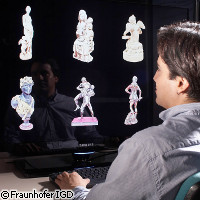3D museum set to come to life
An exciting new EU-funded project is using 3D (three-dimensional) computer graphics technology to digitally archive museum exhibits, which will allow people to see revolving 3D images of exhibits from all over the world. The project, 3D-COFORM ('Tools and expertise for 3D Collection Formation'), has received EUR 8.45 million in funding under the 'Information and Communication Technologies' Theme of the EU's Seventh Framework Programme (FP7). 3D-COFORM brings together 19 partners from European and North African universities, research institutes and prestigious cultural heritage organisations including the Victoria and Albert Museum in London, UK, the Louvre in Paris, France, and the Museum of the Imperial Forums in Rome, Italy. Led by the University of Brighton in the UK, the 3D-COFORM partners' aim is to provide a digital archive of all museum exhibits and a virtual archive from all over the world. Exhibits of all types and sizes will be digitally archived, allowing untold possibilities for museum visitors such as being able to see revolving 3D images of famous statues or taking a virtual walk through an ancient temple. The new technology will be particularly useful for researchers. For instance, historians, anthropologists or art conservators will have a much easier way of studying artefacts. Museum exhibits have always been archived in printed catalogues, but a 3D archive will provide a major advantage over printed publications, allowing complete rotation of exhibits and offering far more information about them, such as style, colour and surface condition. 'But we are still a long way from being able to sensibly correlate 3D data between different objects,' said Dr André Stork, head of department at the Fraunhofer Institute for Computer Graphics Research in Darmstadt, Germany - a partner in the 3D-COFORM consortium. Dr Stork and his research team are currently working on creating 3D models from their own collection at the Fraunhofer Institute and processing them for the new digital archive. 'A 3D scan is basically a cloud of measured points. Further processing is required to map the object properly,' Dr Stork explained. The 3D-COFORM research team is now focused on developing calculation specifications so the 3D models can be accurately set up from the original measured object. For this to be done precisely, the new software used must be able to recognise specific features of an exhibit, such as the arms and legs on a statue or the pattern on a vase. The software also has to be able to depict an object truly - that is, to reproduce every facet, including the shadow cast by a building, for example.
Countries
Germany, United Kingdom

